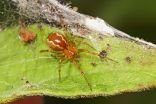INFORMATION:
Title
Ibrutinib treatment ameliorates murine chronic graft-versus-host disease
Author Contact
Bruce R. Blazar
University of Minnesota
612-626-2734
blaza001@umn.edu.
Link to Article
http://www.jci.org/articles/view/75328?key=304ac2fd438ee972d515
B and T cell-targeting drug ameliorates chronic graft-versus-host disease in mice
2014-10-02
(Press-News.org) Hematopoietic stem cells (HSCs) can differentiate into all types of blood cells, including red blood cells and immune cells. While HSC transplantation can be life saving for patients with aggressive forms of blood cancer that are unresponsive to other available treatments, there are many risks associated with the procedure. For example, graft verse host disease (GVHD) results when immune cells generated from donor HSCs attack host tissue. Chronic GVHD occurs over time and is characterized by fibrosis, which impairs organ function. A new study in the Journal of Clinical Investigation demonstrates that targeting T and B cells has potential to ameliorate chronic GVDH. Bruce Blazar and colleagues at the University of Minnesota evaluated the FDA-approved drug ibrutinib in mouse models of chronic GVHD. Ibrutinib blocks both B cell activation and inhibits specific populations of T cells with limited toxicity. In mouse models, ibrutinib reduced chronic GVHD. Importantly, ibrutinib treatment reduced activation of T and B cells isolated from patients with chronic GVHD. The results of this study indicate that active T and B cells drive chronic GVHD and suggest that ibrutinib should be further explored for human GVHD.
ELSE PRESS RELEASES FROM THIS DATE:
Clinical trial evaluates heterologous prime/boost regimens in preventative HIV vaccination
2014-10-02
Almost 40 million people worldwide live with HIV/AIDS, with an estimated 2.5 million new cases per year. Therefore, there has been a large global effort to develop an effective vaccine against the virus. HIV-1 vaccine development has been challenging but recent clinical trials have been promising. A new study in the Journal of Clinical Investigation discusses the results from a clinical trial that evaluated the immune response following different HIV vaccine regimes. Nicole Frahm and colleagues tested prime-boost regimes combining a New York vaccinia HIV clade B (NYVAC-B) ...
Worry, jealousy, moodiness linked to higher risk of Alzheimer's in women
2014-10-01
MINNEAPOLIS – Women who are anxious, jealous, or moody and distressed in middle age may be at a higher risk of developing Alzheimer's disease later in life, according to a nearly 40-year-long study published in the October 1, 2014, online issue of Neurology®, the medical journal of the American Academy of Neurology.
"Most Alzheimer's research has been devoted to factors such as education, heart and blood risk factors, head trauma, family history and genetics," said study author Lena Johannsson, PhD, of the University of Gothenburg in Gothenburg, Sweden. "Personality ...
Hypertension risk rises closer to major roadways
2014-10-01
PROVIDENCE, R.I. [Brown University] — A new study in the Journal of the American Heart Association reports a significant association between living near a major roadway and the risk of high blood pressure.
The Brown University-led analysis of data from 5,400 post-menopausal women in the San Diego metropolitan area found that women who lived within 100 meters of a highway or major arterial road had a 22-percent greater risk of hypertension than women who lived at least 1,000 meters away. In a range of intermediate distances, hypertension risk rose with proximity to the ...
Hospitals with aggressive treatment styles had lower failure-to-rescue rates
2014-10-01
Hospitals with aggressive treatment styles, also known as high hospital care intensity (HCI), had lower rates of patients dying from a major complication (failure to rescue) but longer hospitalizations, writes Kyle H. Sheetz, M.D., M.S., of the Center for Healthcare Outcomes and Policy, Ann Arbor, Mich., and colleagues.
The intensity of medical care varies around the country. Intensity is synonymous with an aggressive treatment style and it has been implicated in rising health care costs, especially during the end-of-life period. Inpatient surgery also is a cost burden. ...
Montmorency tart cherry juice lowered blood uric acid levels and a marker for inflammation
2014-10-01
LANSING, Mich. October 1, 2014 – Tart cherries have long been researched for their association with pain relief – ranging from gout and arthritis joint pain to exercise-related muscle pain. A new study published in the Journal of Functional Foods is the first to report consumption of Montmorency tart cherries caused changes in uric acid metabolism, which can have an impact on joint pain. The study also detected increases in specific anthocyanin compounds in the bloodstream after consuming tart cherries.
In the study, Montmorency tart cherry juice reduced blood levels ...
UMN research pinpoints microRNA tied to colon cancer tumor growth
2014-10-01
MINNEAPOLIS/ST PAUL (October 1, 2014) – Researchers at the University of Minnesota have identified microRNAs that may cause colon polyps from turning cancerous. The finding could help physicians provide more specialized, and earlier, treatment before colon cancer develops.
The findings are published today in The Journal of Pathology.
The American Cancer Society estimates over 134,000 people will be diagnosed with colon cancer in 2014, despite the expanded screening processes now available. This year alone, about 50,000 people will die because of the disease.
Research ...
Fibromyalgia and the role of brain connectivity in pain inhibition
2014-10-01
New Rochelle, NY, October 1, 2014—The cause of fibromyalgia, a chronic pain syndrome is not known. However, the results of a new study that compares brain activity in individuals with and without fibromyalgia indicate that decreased connectivity between pain-related and sensorimotor brain areas could contribute to deficient pain regulation in fibromyalgia, according to an article published in Brain Connectivity, a peer-reviewed journal from Mary Ann Liebert, Inc., publishers. The article is available free on the Brain Connectivity website at http://online.liebertpub.com/doi/full/10.1089/brain.2014.0274 ...
Spiders: Survival of the fittest group
2014-10-01
Along rivers in Tennessee and Georgia, scientists have been studying brownish-orange spiders, called Anelosimus studiosus, that make cobwebby nests "anywhere from the size of a golf ball to the size of a Volkswagen Beetle," researcher Jonathan Pruitt says. The individual spiders are only the size of a pencil eraser, but they form organized groups that can catch prey ranging from fruit flies to small vertebrates. "We have found carcasses of rats and birds inside their colonies," Pruitt says. Unlike most spiders, which are solitary, these social spiders work together in groups.
Now ...
New molecule fights oxidative stress; May lead to therapies for cancer and Alzheimer's
2014-10-01
COLUMBIA, Mo. – Breathing oxygen helps the body create energy for its cells. As a result of the breathing process, reactive molecules called "free radicals" are produced that often cause damage to proteins and genes found in cells. This damage is known as oxidative stress. Free radicals also have been linked to cancer, Alzheimer's and Parkinson's disease. Now, investigators at the University of Missouri have discovered a molecule that treats oxidative stress.
"Oxidative stress can cause damage to the building blocks of a cell, resulting in excessive cell proliferation, ...
Decreased ability to identify odors can predict death
2014-10-01
For older adults, being unable to identify scents is a strong predictor of death within five years, according to a study published October 1, 2014, in the journal PLOS ONE. Thirty-nine percent of study subjects who failed a simple smelling test died during that period, compared to 19 percent of those with moderate smell loss and just 10 percent of those with a healthy sense of smell.
The hazards of smell loss were "strikingly robust," the researchers note, above and beyond most chronic diseases. Olfactory dysfunction was better at predicting mortality than a diagnosis ...





